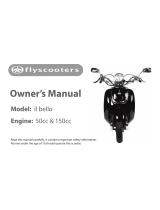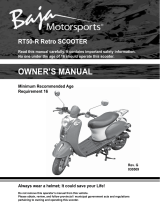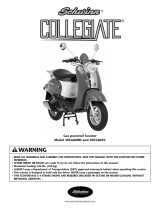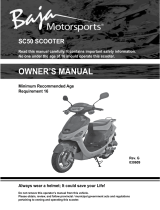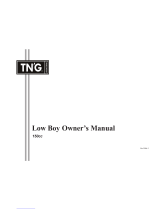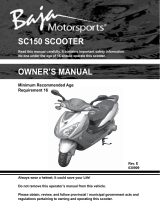Page is loading ...

5C2-F8199-E3
YN50 / YN50M
OWNER’S MANUAL
Read this manual carefully before operating this vehicle.
5C2-F8199-E3 7/9/10 18:10 Página 1

EAU46090
Read this manual carefully before operating this vehicle. This manual should stay with this vehicle if it is
sold.
5C2-F8199-E3 7/9/10 18:10 Página 2

EAU10113
Welcome to the Yamaha world of motorcycling!
As the owner of the YN50 / YN50M, you are benefiting from Yamaha’s vast experience and newest technology regar-
ding the design and manufacture of high-quality products, which have earned Yamaha a reputation for dependability.
Please take the time to read this manual thoroughly, so as to enjoy all advantages of your YN50 / YN50M. The Owner’s
Manual does not only instruct you in how to operate, inspect and maintain your scooter, but also in how to safeguard
yourself and others from trouble and injury.
In addition, the many tips given in this manual will help keep your scooter in the best possible condition. If you have
any further questions, do not hesitate to contact your Yamaha dealer.
The Yamaha team wishes you many safe and pleasant rides. So, remember to put safety first!
Yamaha continually seeks advancements in product design and quality. Therefore, while this manual contains the most
current product information available at the time of printing, there may be minor discrepancies between your scooter
and this manual. If there is any question concerning this manual, please consult a Yamaha dealer.
EWA12411
Please read this manual carefully and completely before operating this scooter.
WARNING
INTRODUCTION
5C2-F8199-E3 7/9/10 18:10 Página 3

EAU10132
Particularly important information is distinguished in this manual by the following notations:
IMPORTANT MANUAL INFORMATION
This is the safety alert symbol. It is used to alert you to potential personal injury
hazards. Obey all safety messages that follow this symbol to avoid possible injury
or death.
A WARNING indicates a hazardous situation which, if not avoided, could result in
death or serious injury.
A NOTICE indicates special precautions that must be taken to avoid damage to the
vehicle or other property.
A TIP provides key information to make procedures easier or clearer.
TIP
NOTICE
WARNING
5C2-F8199-E3 7/9/10 18:10 Página 4

EAUS1172
IMPORTANT MANUAL INFORMATION
YN50 / YN50M
OWNER’S MANUAL
©2010 by YAMAHA MOTOR ESPAÑA S.A.
1st edition, July 2010
All rights reserved.
Any reprinting or unauthorized use
without the written permission of
YAMAHA MOTOR ESPAÑA S.A.
is expressly prohibited.
Printed in Spain.
5C2-F8199-E3 7/9/10 18:10 Página 5

SAFETY INFORMATION.....................1-1
Further safe-riding points .................1-5
DESCRIPTION.....................................2-1
Left view ...........................................2-1
Right view .........................................2-2
Controls and instruments .................2-3
INSTRUMENT AND CONTROL
FUNCTIONS ........................................3-1
Main switch/steering lock.................3-1
Indicator and warning lights .............3-2
Multi-function display .......................3-3
Handlebar switches ..........................3-5
Front brake lever...............................3-6
Rear brake lever................................3-6
Fuel and 2-stroke engine oil tank
caps...............................................3-7
Fuel ...................................................3-8
Fuel tank breather/overflow
hose...............................................3-9
Catalytic converter............................3-9
2-stroke engine oil..........................3-10
Kickstarter.......................................3-10
Seat.................................................3-10
Storage compartment.....................3-11
Luggage hook.................................3-12
FOR YOUR SAFETY –
PRE-OPERATION CHECKS ...............4-1
OPERATION AND IMPORTANT
RIDING POINTS..................................5-1
Starting a cold engine ......................5-1
Starting off ........................................5-1
Acceleration and deceleration..........5-2
Braking..............................................5-2
Tips for reducing fuel
consumption..................................5-3
Engine break-in.................................5-3
Parking..............................................5-4
PERIODIC MAINTENANCE AND
ADJUSTMENT ....................................6-1
Periodic maintenance chart for the
emission control system ...............6-2
General maintenance and
lubrication chart ............................6-3
Removing and installing the
cowling and panel .........................6-6
Checking the spark plug ..................6-7
Final transmission oil ........................6-8
Air filter element................................6-9
Adjusting the carburetor.................6-10
Checking the throttle grip
free play.......................................6-10
Tires ................................................6-10
Cast wheels ....................................6-12
Checking the front brake lever
free play.......................................6-12
Adjusting the rear brake lever
free play.......................................6-13
Checking the front brake pads
and rear brake shoes ..................6-13
Checking the brake fluid level ........6-14
Changing the brake fluid ................6-15
Checking and lubricating the
cables ..........................................6-15
Checking and lubricating the
throttle grip and cable.................6-16
Adjusting the Autolube pump.........6-16
Lubricating the front and rear
brake levers.................................6-16
Checking and lubricating the
centerstand .................................6-17
Checking the front fork...................6-17
Checking the steering.....................6-18
Checking the wheel bearings .........6-18
Battery ............................................6-19
Replacing the fuse..........................6-20
Replacing the headlight bulb..........6-21
Replacing a front turn signal light
bulb .............................................6-22
Replacing a turn signal light bulb
or the tail/brake light bulb ...........6-23
Replacing the license plate light
bulb (Depens on models) ............6-24
Replacing the auxiliary light bulb
(Depens on models) ....................6-24
Troubleshooting ..............................6-25
Troubleshooting chart.....................6-26
TABLE OF CONTENTS
5C2-F8199-E3 7/9/10 18:10 Página 6

SCOOTER CARE AND STORAGE.....7-1
Matte color caution...........................7-1
Care ..................................................7-1
Storage .............................................7-3
SPECIFICATIONS ...............................8-1
CONSUMER INFORMATION .............9-1
Identification numbers ......................9-1
TABLE OF CONTENTS
5C2-F8199-E3 7/9/10 18:10 Página 7

EAUT1016
Be a Responsible Owner
As the vehicle’s owner, you are res-
ponsible for the safe and proper ope-
ration of your scooter.
Scooters are single-track vehicles.
Their safe use and operation are
dependent upon the use of proper
riding techniques as well as the
expertise of the operator. Every ope-
rator should know the following requi-
rements before riding this scooter.
He or she should:
G Obtain thorough instructions
from a competent source on all
aspects of scooter operation.
G Observe the warnings and main-
tenance requirements in this
Owner’s Manual.
G Obtain qualified training in safe
and proper riding techniques.
G Obtain professional technical
service as indicated in this
Owner’s Manual and/or when
made necessary by mechanical
conditions.
Safe Riding
Perform the pre-operation checks
each time you use the vehicle to
make sure it is in safe operating con-
dition. Failure to inspect or maintain
the vehicle properly increases the
possibility of an accident or equip-
ment damage. See page 4-1 for a list
of pre-operation checks.
G This scooter is designed to carry
the operator and a passenger.
TIP
Although this scooter is designed to
carry a passenger, always comply
with the local regulations.
G The failure of motorists to detect
and recognize scooters in traffic
is the predominating cause of
automobile/scooter accidents.
Many accidents have been cau-
sed by an automobile driver who
did not see the scooter. Making
yourself conspicuous appears to
be very effective in reducing the
chance of this type of accident.
Therefore:
• Wear a brightly colored jacket.
• Use extra caution when you
are approaching and passing
through intersections, since
intersections are the most
likely places for scooter acci-
dents to occur.
• Ride where other motorists can
see you. Avoid riding in anot-
her motorist’s blind spot.
G Many accidents involve inexpe-
rienced operators. In fact, many
operators who have been invol-
ved in accidents do not even
have a current driver’s license.
• Make sure that you are quali-
fied and that you only lend your
scooter to other qualified ope-
rators.
• Know your skills and limits.
Staying within your limits may
help you to avoid an accident.
• We recommend that you prac-
tice riding your scooter where
there is no traffic until you have
become thoroughly familiar
with the scooter and all of its
controls.
G Many accidents have been cau-
sed by error of the scooter ope-
1
SAFETY INFORMATION
1-1
5C2-F8199-E3 7/9/10 18:10 Página 8

rator. A typical error made by the
operator is veering wide on a turn
due to excessive speed or under-
cornering (insufficient lean angle
for the speed).
• Always obey the speed limit
and never travel faster than
warranted by road and traffic
conditions.
• Always signal before turning or
changing lanes. Make sure that
other motorists can see you.
G The posture of the operator and
passenger is important for proper
control.
• The operator should keep both
hands on the handlebar and
both feet on the operator foo-
trests during operation to
maintain control of the scooter.
• The passenger should always
hold onto the operator, the seat
strap or grab bar, if equipped,
with both hands and keep both
feet on the passenger foo-
trests. Never carry a passenger
unless he or she can firmly pla-
ce both feet on the passenger
footrests.
G Never ride under the influence of
alcohol or other drugs.
G This scooter is designed for on-
road use only. It is not suitable for
off-road use.
Protective apparel
The majority of fatalities from scooter
accidents are the result of head inju-
ries. The use of a safety helmet is the
single most critical factor in the pre-
vention or reduction of head injuries.
G Always wear an approved hel-
met.
G Wear a face shield or goggles.
Wind in your unprotected eyes
could contribute to an impair-
ment of vision that could delay
seeing a hazard.
G The use of a jacket, substantial
shoes, trousers, gloves, etc., is
effective in preventing or redu-
cing abrasions or lacerations.
G Never wear loose-fitting clothes,
otherwise they could catch on
the control levers or wheels and
cause injury or an accident.
G Always wear protective clothing
that covers your legs, ankles, and
feet. The engine or exhaust sys-
tem become very hot during or
after operation and can cause
burns.
G A passenger should also observe
the above precautions.
Avoid Carbon Monoxide Poisoning
All engine exhaust contains carbon
monoxide, a deadly gas. Breathing
carbon monoxide can cause heada-
ches, dizziness, drowsiness, nausea,
confusion, and eventually death.
Carbon Monoxide is a colorless,
odorless, tasteless gas which may be
present even if you do not see or
smell any engine exhaust. Deadly
levels of carbon monoxide can collect
rapidly and you can quickly be over-
come and unable to save yourself.
Also, deadly levels of carbon monoxi-
de can linger for hours or days in
enclosed or poorly ventilated areas. If
you experience any symptoms of car-
bon monoxide poisoning, leave the
area immediately, get fresh air, and
SEEK MEDICAL TREATMENT.
G Do not run engine indoors. Even
if you try to ventilate engine
1
SAFETY INFORMATION
1-2
5C2-F8199-E3 7/9/10 18:10 Página 9

exhaust with fans or open win-
dows and doors, carbon monoxi-
de can rapidly reach dangerous
levels.
G Do not run engine in poorly venti-
lated or partially enclosed areas
such as barns, garages, or car-
ports.
G Do not run engine outdoors whe-
re engine exhaust can be drawn
into a building through openings
such as windows and doors.
Loading
Adding accessories or cargo to your
scooter can adversely affect stability
and handling if the weight distribution
of the scooter is changed. To avoid
the possibility of an accident, use
extreme caution when adding cargo
or accessories to your scooter. Use
extra care when riding a scooter that
has added cargo or accessories.
Here, along with the information
about accessories below, are some
general guidelines to follow if loading
cargo to your scooter:
The total weight of the operator, pas-
senger, accessories and cargo must
not exceed the maximum load limit.
Operation of an overloaded vehicle
could cause an accident.
When loading within this weight limit,
keep the following in mind:
G Cargo and accessory weight
should be kept as low and close
to the scooter as possible. Secu-
rely pack your heaviest items as
close to the center of the vehicle
as possible and make sure to dis-
tribute the weight as evenly as
possible on both sides of the
scooter to minimize imbalance or
instability.
G Shifting weights can create a
sudden imbalance. Make sure
that accessories and cargo are
securely attached to the scooter
before riding. Check accessory
mounts and cargo restraints fre-
quently.
• Properly adjust the suspension
for your load (suspension-
adjustable models only), and
check the condition and pres-
sure of your tires.
• Never attach any large or
heavy items to the handlebar,
front fork, or front fender. Such
items can create unstable
handling or a slow steering res-
ponse.
G This vehicle is not designed to
pull a trailer or to be attached
to a sidecar.
Genuine Yamaha Accessories
Choosing accessories for your vehicle
is an important decision. Genuine
Yamaha accessories, which are avai-
lable only from a Yamaha dealer, have
been designed, tested, and approved
by Yamaha for use on your vehicle.
Many companies with no connection
to Yamaha manufacture parts and
accessories or offer other modifica-
tions for Yamaha vehicles. Yamaha is
not in a position to test the products
that these aftermarket companies
produce. Therefore, Yamaha can neit-
her endorse nor recommend the use
of accessories not sold by Yamaha or
Maximum load:
163 kg (359 lb)
1
SAFETY INFORMATION
1-3
5C2-F8199-E3 7/9/10 18:10 Página 10

modifications not specifically recom-
mended by Yamaha, even if sold and
installed by a Yamaha dealer.
Aftermarket Parts, Accessories,
and Modifications
While you may find aftermarket pro-
ducts similar in design and quality to
genuine Yamaha accessories, recog-
nize that some aftermarket accesso-
ries or modifications are not suitable
because of potential safety hazards to
you or others. Installing aftermarket
products or having other modifica-
tions performed to your vehicle that
change any of the vehicle’s design or
operation characteristics can put you
and others at greater risk of serious
injury or death. You are responsible
for injuries related to changes in the
vehicle.
Keep the following guidelines in mind,
as well as those provided under “Loa-
ding” when mounting accessories.
G Never install accessories or carry
cargo that would impair the per-
formance of your scooter. Care-
fully inspect the accessory befo-
re using it to make sure that it
does not in any way reduce
ground clearance or cornering
clearance, limit suspension tra-
vel, steering travel or control ope-
ration, or obscure lights or reflec-
tors.
• Accessories fitted to the hand-
lebar or the front fork area can
create instability due to impro-
per weight distribution or
aerodynamic changes. If
accessories are added to the
handlebar or front fork area,
they must be as lightweight as
possible and should be kept to
a minimum.
• Bulky or large accessories may
seriously affect the stability of
the scooter due to aerodyna-
mic effects. Wind may attempt
to lift the scooter, or the scoo-
ter may become unstable in
cross winds. These accesso-
ries may also cause instability
when passing or being passed
by large vehicles.
• Certain accessories can dis-
place the operator from his or
her normal riding position.
This improper position limits
the freedom of movement of
the operator and may limit
control ability, therefore, such
accessories are not recom-
mended.
G Use caution when adding electri-
cal accessories. If electrical
accessories exceed the capacity
of the scooter’s electrical system,
an electric failure could result,
which could cause a dangerous
loss of lights or engine power.
Aftermarket Tires and Rims
The tires and rims that came with your
scooter were designed to match the
performance capabilities and to pro-
vide the best combination of hand-
ling, braking, and comfort. Other tires,
rims, sizes, and combinations may
not be appropriate. Refer to page
6-10 for tire specifications and more
information on replacing your tires.
Transporting the Scooter
Be sure to observe following instruc-
tions before transporting the scooter
in another vehicle.
1
SAFETY INFORMATION
1-4
5C2-F8199-E3 7/9/10 18:10 Página 11

G Remove all loose items from the
scooter.
G Point the front wheel straight
ahead on the trailer or in the truck
bed, and choke it in a rail to pre-
vent movement.
G Secure the scooter with tie-
downs or suitable straps that are
attached to solid parts of the
scooter, such as the frame or
upper front fork triple clamp (and
not, for example, to rubber-
mounted handlebars or turn sig-
nals, or parts that could break).
Choose the location for the
straps carefully so the straps will
not rub against painted surfaces
during transport.
G The suspension should be com-
pressed somewhat by the tie-
downs, if possible, so that the
scooter will not bounce excessi-
vely during transport.
EAU10372
Further safe-riding points
G Be sure to signal clearly when
making turns.
G Braking can be extremely difficult
on a wet road. Avoid hard bra-
king, because the scooter could
slide. Apply the brakes slowly
when stopping on a wet surface.
G Slow down as you approach a
corner or turn. Once you have
completed a turn, accelerate
slowly.
G Be careful when passing parked
cars. A driver might not see you
and open a door in your path.
G Railroad crossings, streetcar
rails, iron plates on road cons-
truction sites, and manhole
covers become extremely slip-
pery when wet. Slow down and
cross them with caution. Keep
the scooter upright, otherwise it
could slide out from under you.
G The brake pads could get wet
when you wash the scooter. After
washing the scooter, check the
brakes before riding.
G Always wear a helmet, gloves,
trousers (tapered around the cuff
and ankle so they do not flap),
and a bright colored jacket.
G Do not carry too much luggage
on the scooter. An overloaded
scooter is unstable. Use a strong
cord to secure any luggage to the
carrier (if equipped). A loose load
will affect the stability of the sco-
oter and could divert your atten-
tion from the road. (See page
1-1).
1
SAFETY INFORMATION
1-5
5C2-F8199-E3 7/9/10 18:10 Página 12

EAU10410
Left view
DESCRIPTION
2-1
2
1. Storage compartment (page 3-11)
2. Shock absorber assembly
3. Final transmission oil filler cap (page 6-8)
4. Brake lever free play adjusting nut (page 6-13)
5. Final transmission oil drain bolt (page 6-8)
6. Kickstarter (page 3-10)
7. Air filter element (page 6-9)
8. Front brake pads (page 6-13)
5C2-F8199-E3 7/9/10 18:10 Página 1

EAU10420
Right view
DESCRIPTION
2-2
2
1. Grab bar (page 5-1)
2. Fuel tank cap (page 3-7)
3. 2-stroke engine oil tank (page 3-7/3-10)
4. Seat (page 3-10)
5. Battery (page 6-19)
6. Fuses (page 6-20)
7. Luggage hook (page 3-12)
8. Main switch/steering lock (page 3-1)
9. Passenger footrest
10. Centerstand (page 6-17)
5C2-F8199-E3 7/9/10 18:10 Página 2

EAU10430
Controls and instruments
DESCRIPTION
2-3
2
1. Rear brake lever (page 3-6)
2. Left handlebar switches (page 3-5)
3. Multi-function display (page 3-3)
4. Right handlebar switch (page 3-5)
5. Throttle grip (page 6-10)
6. Front brake lever (page 3-6)
5C2-F8199-E3 7/9/10 18:10 Página 3

EAU10460
Main switch/steering lock
The main switch/steering lock con-
trols the ignition and lighting systems,
and is used to lock the steering. The
various positions are described
below.
EAUS1381
ON “ ”
All electrical circuits are supplied with
power, the meter lighting comes on,
and the engine can be started. The
key cannot be removed.
TIP
The headlight and taillight come on
automatically when the engine is star-
ted.
EAU47791
OFF “ ”
All electrical systems are off. The key
can be removed.
EWA15350
Never turn the key to “ ” or “ ”
while the vehicle is moving.
Otherwise the electrical systems
will be switched off, which may
result in loss of control or an acci-
dent.
EAU10681
LOCK “ ”
The steering is locked, and all electri-
cal systems are off. The key can be
removed.
To lock the steering
1. Push
2. Turn
1. Turn the handlebars all the way to
the left.
2. Push the key in from the “ ”
position, and then turn it to “ ”
while still pushing it.
3. Remove the key.
To unlock the steering
1. Push
2. Turn
Push the key in, and then turn it to
“ ” while still pushing it.
WARNING
INSTRUMENT AND CONTROL FUNCTIONS
3-1
3
5C2-F8199-E3 7/9/10 18:10 Página 4

EAU11004
Indicator and warning lights
1. 2-stroke engine oil level warning light “ ”
2. High beam indicator light “ ”
3. Turn signal indicator light “ ”
4. Fuel level warning indicator “ ”
EAU11020
Turn signal indicator light “ ”
This indicator light flashes when the
turn signal switch is pushed to the left
or right.
EAU11080
High beam indicator light “ ”
This indicator light comes on when
the high beam of the headlight is swit-
ched on.
EAUM1062
Oil level warning light “ ”
This warning light comes on when the
key is in the “ ” position or if the oil
level in the 2-stroke engine oil tank is
low during operation. If the warning
light comes on during operation, stop
immediately and fill the oil tank with
2-stroke engine oil of either JASO
grade “FC” or ISO grades “EG-C” or
“EG-D”. The warning light should go
off after the 2-stroke engine oil tank
has been refilled.
TIP
If the warning light does not come on
when the key is in the “ ” position
or does not go off after the 2-stroke
engine oil tank has been refilled, have
a Yamaha dealer check the electrical
circuit.
ECA16291
Do not operate the vehicle until you
know that the engine oil level is suf-
ficient.
EAU11352
Fuel level warning light “ ”
This warning light comes on when the
fuel level drops below approximately
1.4 L (0.37 US gal, 0.31 Imp.gal).
When this occurs, refuel as soon as
possible.
The electrical circuit of the warning
light can be checked by turning the
key to “ ”. The warning light should
come on for a few seconds, and then
go off.
If the warning light does not come on
initially when the key is turned to “ ”,
or if the warning light remains on,
have a Yamaha dealer check the elec-
trical circuit.
NOTICE
INSTRUMENT AND CONTROL FUNCTIONS
3-2
3
5C2-F8199-E3 7/9/10 18:10 Página 5

EAUS1394
Multi-function display
1. Clock
2. Speedometer
3. Fuel gauge
4. Odometer/tripmeter/fuel reserve tripmeter
5. “RESET/SELECT” button
TIP
The multi-function display performs
the following self-test for three
seconds in order to check the electri-
cal circuit.
G The speedometer digits display
from 0 to 99, and then from 99 to
0 in kilometers. If the speedome-
ter is set to miles, the digits dis-
play from 0 to 65, and then from
65 to 0.
G All LCD segments and warning
lights come on and then go off.
EWA12312
Be sure to stop the vehicle before
making any setting changes to the
multi-function display. Changing
settings while riding can distract
the operator and increase the risk
of an accident.
The multi-function display is equip-
ped with the following:
G a digital clock
G a digital speedometer (which
shows riding speed)
G an odometer (which shows the
total distance traveled)
G a tripmeter (which shows the dis-
tance traveled since it was last
set to zero)
G a fuel reserve tripmeter (which
shows the distance traveled on
the fuel reserve)
G a fuel gauge
G a self-diagnosis device
TIP
G Be sure to turn the key to “ ”
before using the button.
G For the U.K. only: To switch the
speedometer and odometer/trip-
meter displays between kilome-
ters and miles, when the main
switch is turned to “ ”, press
the button for at least eight
seconds.
To set the clock:
1. Select the odometer and push
the button for at least three
seconds.
2. When the hour digits start flas-
hing, push the button to set the
hours.
WARNING
INSTRUMENT AND CONTROL FUNCTIONS
3-3
3
5C2-F8199-E3 7/9/10 18:10 Página 6

3. To change the minutes digits,
push the button for at least three
seconds.
4. When the minutes digits start
flashing, push the button to set
the minutes.
5. Push the button for at least three
seconds to start the clock.
TIP
After setting the clock, be sure to
push the button for at least three
seconds before turning the key to
“ ”, otherwise the clock will not be
set.
Odometer and tripmeter modes
Pushing the button switches the dis-
play between the odometer mode
“ODO” and the tripmeter “TRIP” in
the following order:
ODO 씮 TRIP 씮 ODO
If the fuel level warning indicator
comes on (see page 3-2), the odome-
ter display will automatically change
to the fuel reserve tripmeter mode
“TRIP F” and start counting the dis-
tance traveled from that point. In that
case, pushing the button switches the
display between the various tripmeter
and odometer modes in the following
order:
TRIP F 씮 ODO 씮 TRIP 씮 TRIP F
To reset a tripmeter, select it by pus-
hing the button, and then push it
again for at least three seconds. If you
do not reset the fuel reserve tripmeter
manually, it will reset itself automati-
cally and the display will return to the
prior mode after refueling and trave-
ling 5 km (3 mi).
TIP
The display cannot be changed back
to “TRIP F” after pushing the button.
Fuel gauge
The fuel gauge indicates the amount
of fuel in the fuel tank. The display
segments of the fuel gauge disappear
towards “E” (Empty) as the fuel level
RESET/
SELECT
RESET/
SELECT
RESET/
SELECT
RESET/
SELECT
RESET/
SELECT
INSTRUMENT AND CONTROL FUNCTIONS
3-4
3
5C2-F8199-E3 7/9/10 18:10 Página 7

decreases. When only two segments
are left near “E”, the fuel level warning
indicator comes on. Refuel as soon
as possible.
Self-diagnosis device
This model is equipped with a self-
diagnosis device for the fuel electrical
circuit.
If a problem is detected in the fuel
electrical circuit, all LCD segments of
the fuel gauge and the fuel level war-
ning indicator will flash. If this occurs,
have a Yamaha dealer check the vehi-
cle.
EAU12348
Handlebar switches
Left
1. Dimmer switch “ / ”
2. Turn signal switch “ / ”
3. Horn switch “ ”
Right
1. Start switch “ ”
INSTRUMENT AND CONTROL FUNCTIONS
3-5
3
5C2-F8199-E3 7/9/10 18:10 Página 8
/
